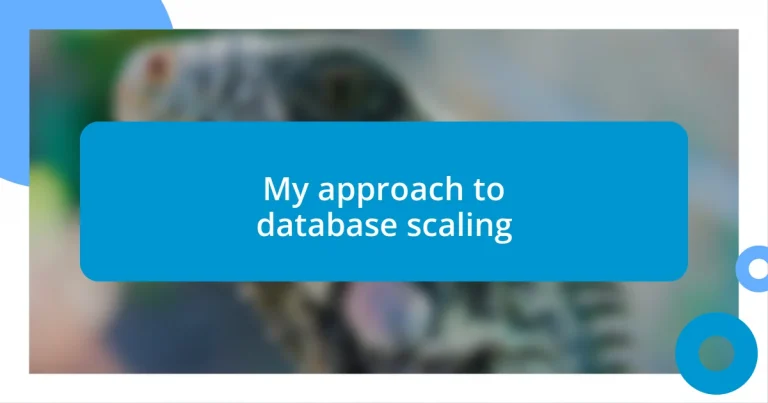Key takeaways:
- Two main scaling strategies are vertical (upgrading existing hardware) and horizontal (adding servers), each with its benefits and limitations.
- Proactive assessment of scalability requirements, including user load and query performance, is crucial to avoid downtime and enhance application reliability.
- Effective scaling combines technical strategies with team collaboration, documentation, and query optimization to improve performance and user satisfaction.
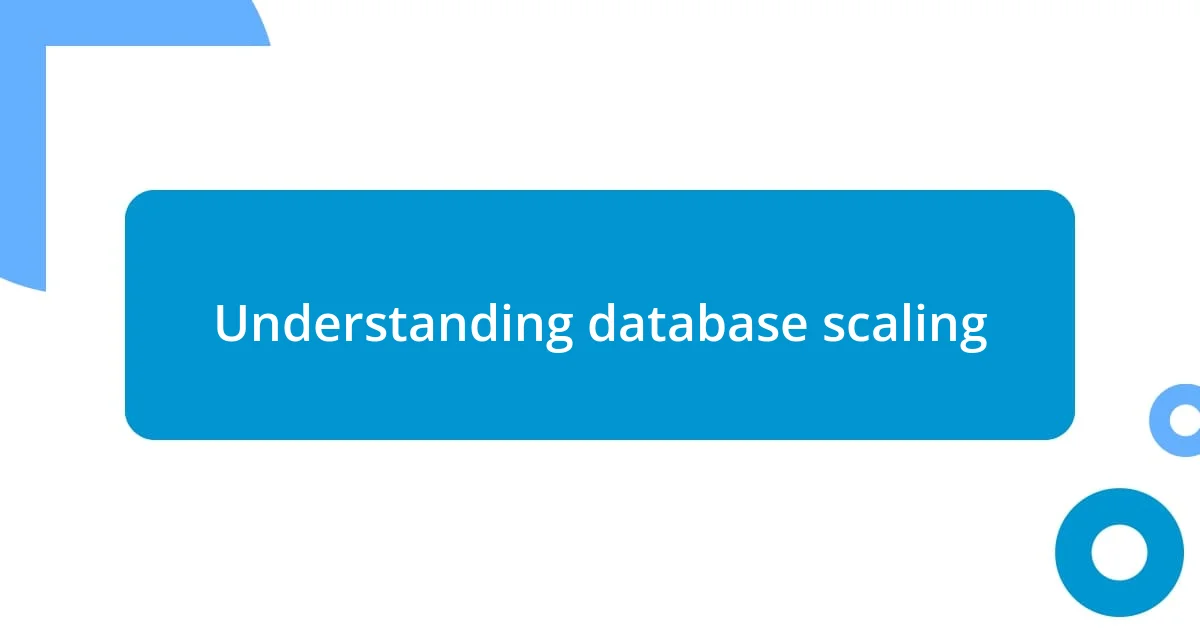
Understanding database scaling
Scaling a database is like tuning a finely crafted instrument; it requires precision and understanding of what each component contributes to the overall harmony. I still remember the first time I faced the challenge of a rapidly growing user base. Our queries started slowing down, and I could feel the mounting pressure; it was a turning point where I realized the importance of scaling as an integral part of maintaining performance.
There are two primary strategies for database scaling: vertical and horizontal scaling. Vertical scaling involves enhancing the existing server’s resources—think more CPU or RAM—while horizontal scaling spreads the load across multiple servers. Have you ever felt the strain of a bottleneck? I definitely have. When we opted for horizontal scaling, it felt like a weight had been lifted; suddenly, our application flowed smoothly, and user satisfaction skyrocketed.
Understanding your database needs is crucial for effective scaling. Each application is like a living organism with unique growth patterns and demands. Reflecting on my experience, I’ve learned that preemptively planning for scaling can save countless headaches later. So, how prepared are you for unexpected changes in data load? In my journey, I’ve found that proactive strategies often pay off in the long run.
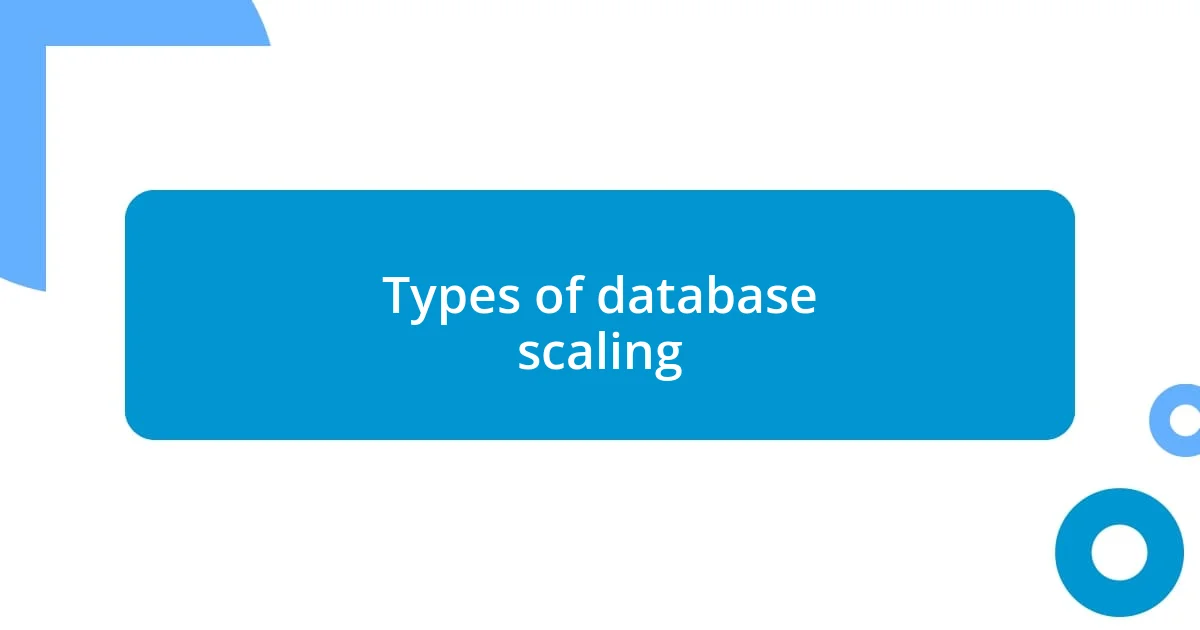
Types of database scaling
When it comes to scaling databases, I often think of vertical scaling as putting a bigger engine in a car. You’re essentially upgrading the machine to handle more traffic, which, at times, can seem like a quick fix. I recall a project where we maxed out our database by simply adding more RAM. However, despite the initial satisfaction, we later learned that this approach has its limits and can lead to downtime during upgrades.
On the other hand, horizontal scaling always strikes me as building a fleet of vehicles instead of just one. It gives you the advantage of adding more servers to manage increased workload without overwhelming a single system. When we adopted this method, it was a revelation! Suddenly, our application could handle spikes in traffic without crashing, which reminded me of the difference between driving a solitary car and cruising in a convoy—it felt much more reliable and robust.
Lastly, understanding the trade-offs between these two types of scaling is pivotal. Vertical scaling might be simpler to implement initially, but horizontal scaling offers greater flexibility in the long term. I remember grappling with this dilemma while working on an important application. We chose to invest in horizontal scaling even though it was more complex. Looking back, that decision shaped our growth trajectory for years to come.
| Type | Description |
|---|---|
| Vertical Scaling | Upgrading existing hardware resources like CPU and RAM. |
| Horizontal Scaling | Adding more servers to distribute the load evenly. |
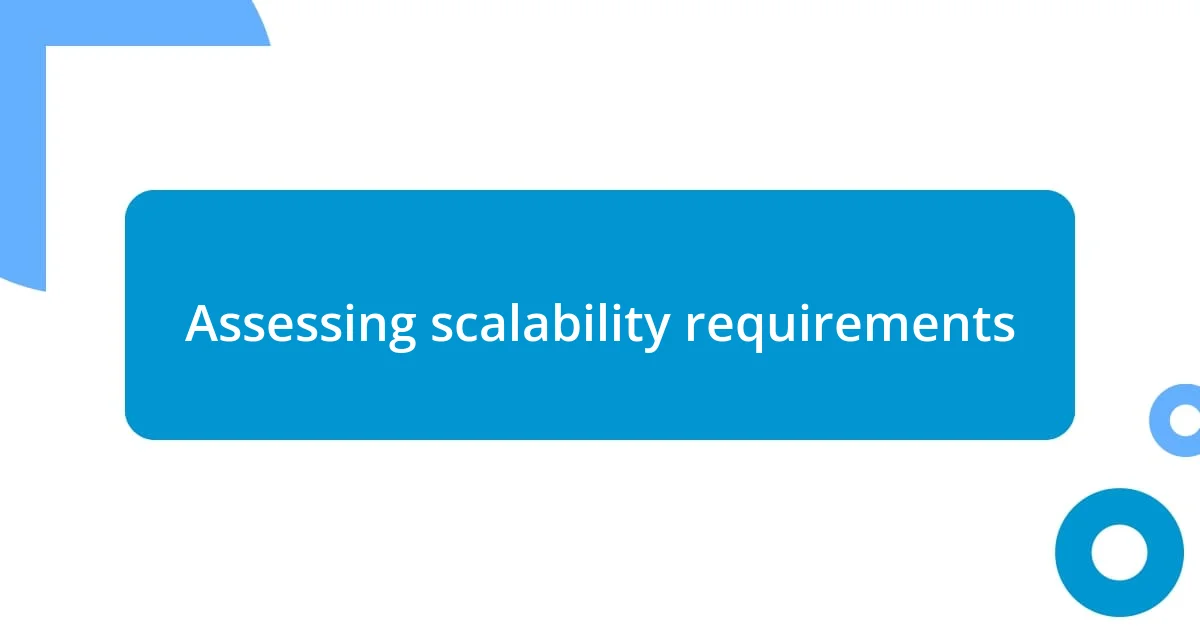
Assessing scalability requirements
To assess scalability requirements effectively, it’s essential to understand both current and projected workloads. I can’t emphasize enough how critical it is to accurately gauge user demand and the complexity of associated queries. I remember once when a sudden surge in users caught us off guard. We didn’t anticipate the pressure on our database, and it led to a frustrating experience for everyone involved.
Here are some key factors to consider:
- Current user load: Analyze how many users actively use your application and their usage patterns.
- Growth projections: Anticipate future growth by reviewing historical data and trends.
- Query performance: Evaluate the types of queries being run and their execution times.
- Peak usage times: Identify when your system experiences the highest load and how often this occurs.
- Data storage needs: Consider how much storage you’ll require, not just for current data but for anticipated growth.
Identifying these elements helps construct a roadmap for scalability that aligns with real-world scenarios. I’ve learned that neglecting these assessments can lead to drastic consequences, like downtime or decreased performance, which no one wants to experience. In one project, failing to account for an influx of seasonal users resulted in a chaotic few days. It was a tough lesson, but it underscored the importance of foresight in scalability planning.
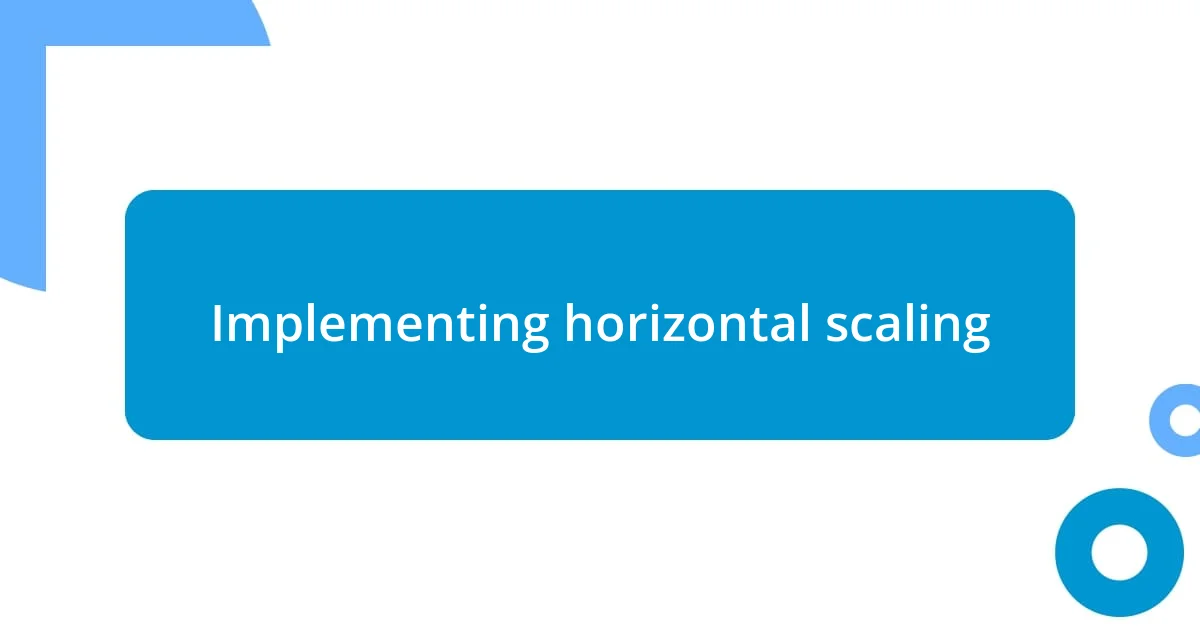
Implementing horizontal scaling
Implementing horizontal scaling in a database often involves partitioning data across multiple servers, commonly known as sharding. I still vividly recall the first time we implemented this in a project. The daunting task of breaking the data into segments seemed overwhelming at first, but once we divided it smartly, it felt like discovering how to piece together a puzzle. Each shard operated independently, and I could almost hear the sigh of relief from our application as it handled increased loads effortlessly.
Another critical aspect involves load balancing, ensuring that requests are distributed evenly among the servers. I remember a time when we didn’t optimize our load balancer adequately. It became a bottleneck, causing some servers to be overloaded while others sat idle, waiting for requests. That experience taught me how essential it is to monitor and adjust load distribution continually—it’s a bit like conducting an orchestra where each section needs to play in harmony to create a beautiful symphony.
Finally, integrating a consistent backup and recovery strategy across all nodes cannot be overstated. I felt a wave of panic when a corrupted shard nearly jeopardized our entire application. Had we not established regular backups and a solid recovery plan, we would have been in a precarious position. This incident reinforced my belief that horizontal scaling, while offering fantastic benefits, requires diligent management and a proactive approach to data integrity. It’s about building resilience as well as capacity, paving a smoother road for growth.
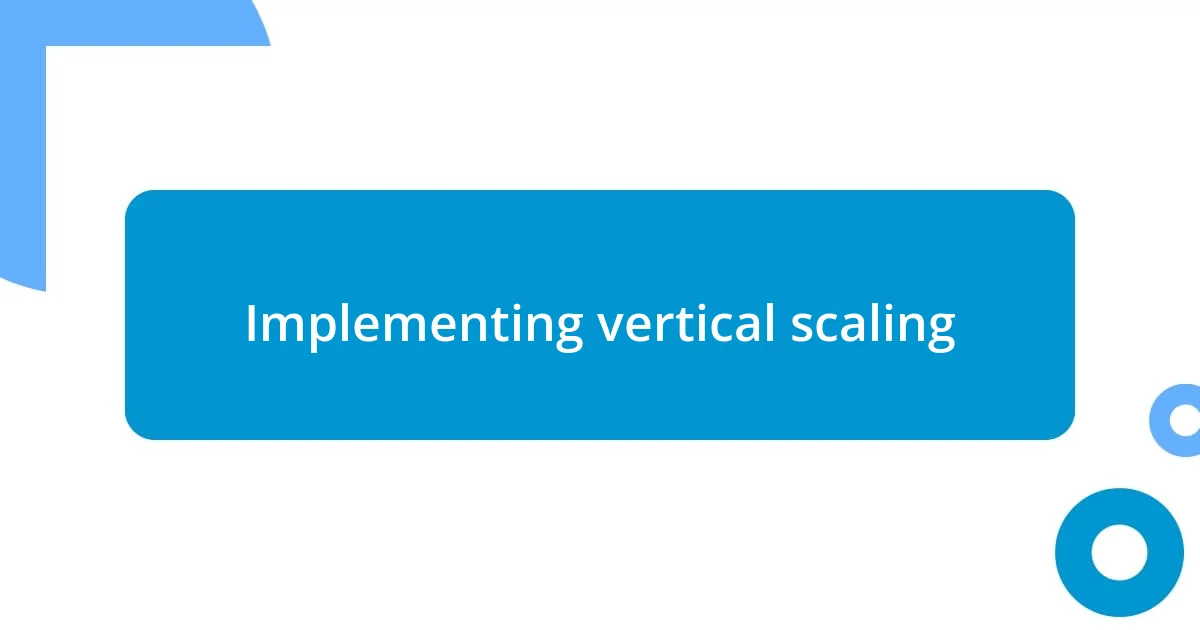
Implementing vertical scaling
Vertical scaling, or scaling up, involves upgrading your existing server resources to handle increased loads. I recall a project where we opted for a larger server to enhance performance. Initially, it felt like a straightforward solution, but I soon learned that simply adding more RAM or faster CPUs doesn’t always equate to improved efficiency. The transition illuminated the importance of balancing performance with cost—it’s a dance between capability and budget.
A key factor in implementing vertical scaling is monitoring performance closely during the upgrade. I remember a particularly stressful moment when, after a big hardware update, we faced unexpected bottlenecks. It turned out that our existing architecture couldn’t fully leverage the new resources. This experience taught me to analyze not just the hardware but also how it’s configured within the system. It’s crucial to ensure that the software can utilize the hardware effectively; otherwise, you might end up with a high-powered machine that’s still sluggish.
While vertical scaling can be less complex than horizontal scaling, it has its limits. I often ask myself, when do you know it’s time to switch strategies? During the same project, we eventually hit the ceiling on what our upgraded server could handle. It was then I realized that vertical scaling might extend your capabilities temporarily, but eventually, you’ll need to explore additional avenues, like horizontal scaling, for sustainable growth. That journey from upward scaling to considering multi-server environments revealed deep insights into managing database performance and user satisfaction.
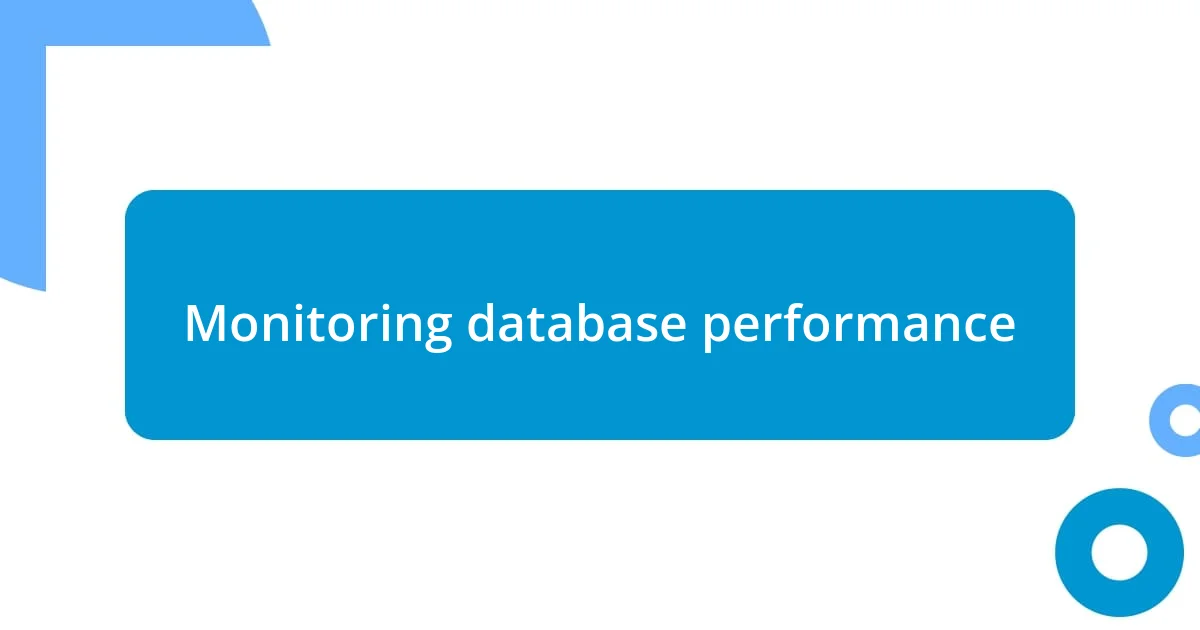
Monitoring database performance
Monitoring database performance is a critical component of ensuring optimal functionality. I recall a time when we implemented real-time performance tracking tools, and it was transformative. Suddenly, we could visualize bottlenecks as they occurred, almost like being given a backstage pass to a concert—you see everything happening behind the scenes that others might miss. This level of oversight allowed us to make informed decisions promptly, preventing issues before they spiraled out of control.
One challenge we faced was figuring out which metrics were most important. I remember being inundated with data but feeling lost in deciphering its significance. It wasn’t until we prioritized key performance indicators, like query response times and transaction throughput, that we really saw the light. Focusing on the most impactful areas allowed us to tailor our monitoring efforts and streamline our database operations efficiently, turning a confusing array of statistics into actionable insights.
Moreover, I learned the value of proactive monitoring rather than just reactive fixes. There was this moment during a holiday season when we mistakenly thought we could rely solely on historical data to predict traffic. The surge was unexpected—like planning a picnic only to have a sudden downpour. By constantly monitoring performance, we could dynamically adapt our resources to meet demand, ensuring our users had a seamless experience when it mattered most. It’s an ongoing process that requires vigilance and a willingness to evolve with the changing landscape of technology.
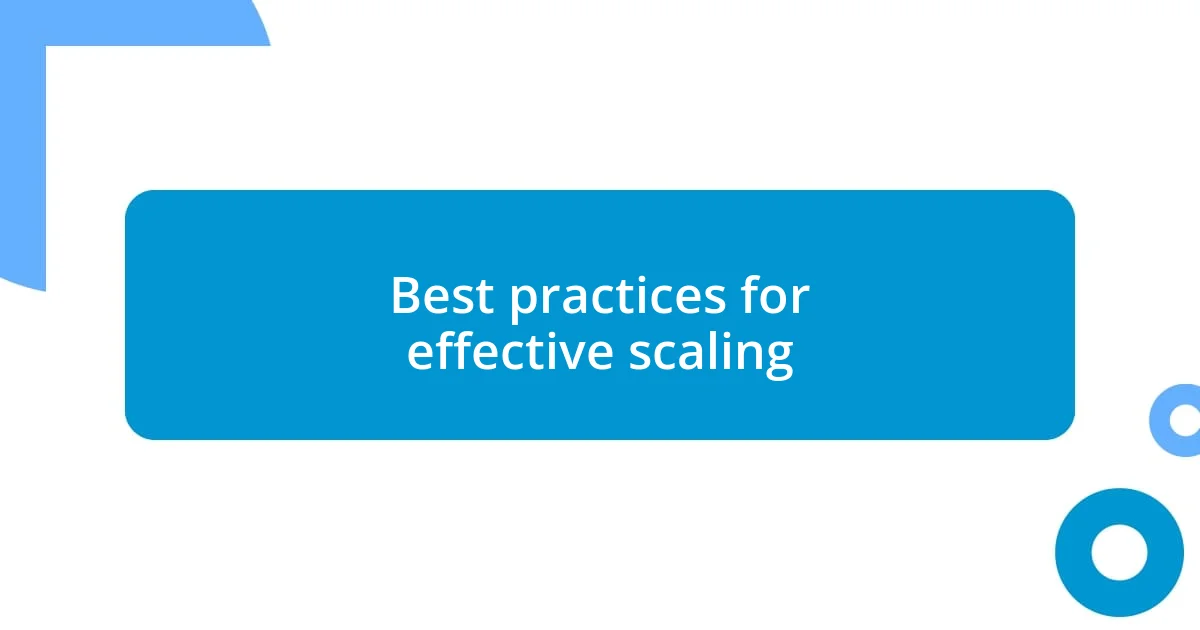
Best practices for effective scaling
Scaling a database effectively requires not only technical strategies but also a deep understanding of your evolving needs. I’ve often found that establishing clear priorities based on user demands can guide your scaling decisions. For instance, during a mobile app launch, we focused on expanding read replicas to reduce database load and improve response times. Watching our users benefit from faster interactions filled me with a sense of accomplishment, reinforcing the idea that scaling isn’t just about numbers—it’s about enhancing the user experience.
Another crucial practice is optimizing your queries and database structure before diving into expansive scaling solutions. I remember a project where we rushed into scaling without tackling inefficient queries upfront. The result? We hit limits faster than anticipated, leaving us scrambling. I’ve learned that regularly reviewing and fine-tuning those queries not only improves performance but can often delay or reduce the necessity for scaling, which translates to cost savings and better system health.
Lastly, don’t underestimate the power of documentation and team communication during scaling efforts. When we transitioned to a distributed database model, I quickly discovered that sharing our challenges and successes with the team was vital. It created a culture of collaboration where everyone felt invested in the process. Have you ever experienced the thrill of a shared victory? When we finally achieved a smoother scaling process as a team, it was a game-changer. Documenting our strategies and lessons learned didn’t just build a knowledge base; it established a roadmap for future projects, making scaling feel less daunting and more like an achievable adventure.












